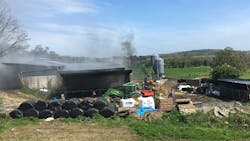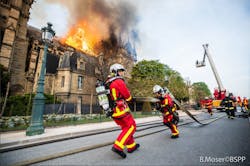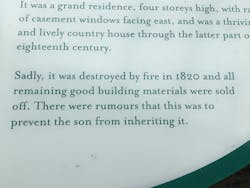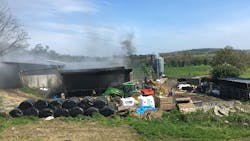Fire is fire, no matter where you are
While many threats are regionally specific, the threat of fire knows no geographical, economic or climatological boundaries. It can strike and devastate at any time, any place, to any person, and can be equally as devastating to all. Maybe it was because the Notre Dame fire kicked off my Ireland tour, or because of my natural geekiness towards fire history and prevention, or maybe simply because of its prevalence in history, but seemingly every historical location I visited where its history was displayed for visitors, the word “FIRE” continuously stood out. Fire either led to the devastation of the location, its resettlement or reconstruction, or fire was one of the major considerations in construction (next to defense). Of course, it’s also important to note that fire was used very effectively as a weapon throughout history as it still is being used today. Fire, fire, fire, from BC to AD, not a page can be turned without fire shaping history and providing lessons. As it will now again with the Notre Dame Cathedral.
There is no doubt Notre Dame will be rebuilt, and future tourists will visit and read about this fire and how it reshaped the Cathedral from what is was into what it is now. While the previous history of the Cathedral can be documented, many of the artifacts are now lost to ash. Instead of seeing these historical symbols live and in real-time breathtaking historical grandeur, causing those witnessing them to beNotre Dame is located in the birthplace of our fire history. The Great London fire of 1666 began, or significantly contributed to, the fire protection brought here to the colonies. After this fire, London was rebuilt with fire protection in mind. Yet several conflagrations still occurred; from the 1802 Portsmouth, NH, fire which led to the first Congressional disaster relief legislation, to what can be argued is still occurring in present times with the California wildfires, there is not a historical period where fire has not, or is not, making an impact. Accordingly, in every nation stands a group of men and women who continue to risk life and limb battling man’s oldest and deadliest enemy for the preservation of life, history, and culture; firefighter, bombero, feuerwehrmann, brandweerman, strażak, lính cứu hỏa, رجال الاطفاء. Regardless of the pronunciation or spelling of the name, the job and the dangers are universal, and the bonding shared by those possessing that title would be the envy of any peace accord or international relations treaty.
What about the standards?
We must ask why fire continues to plague us? The cure for this disease is well known globally: a robust and fully equipped firefighting force, adherence to codes provided by historic losses, and sprinkler systems. The National Fire Protect Association (NFPA) standards, according to a 2016 article in the NFPA Journal written by Donald Bliss titled “Standards without Borders,” are in use in over 50 countries and have been translated into 14 languages. The NFPA boasts a membership of over 50,000 individuals globally and was born from a 1896 meeting concerning sprinkler systems. NFPA standards address every conceivable approach to fire protection from staffing to nuclear reactor plants, and each individual standard is in itself a historical lesson in lives, history, and cultures lost. Why is this history being largely ignored by our communities at the risk of losing their very own?
According to an Associated Press article, Notre Dame was “a treasure trove, housing priceless and irreplaceable marvels of immense religious, artistic, musical, historical and architectural value.” While the cause of the fire is still not known, we can be certain there was a disregarded standard and history lesson that would have prevented it, contained it, and significantly reduced damages. Why are we ignoring them?
Those who do not learn from history are doomed to repeat it, and it is painfully and tragically apparent that our societies have not learned the lessons handed down by so many communities and lives lost. An ethos from those within the educator/instructor community states boldly that, “If the student failed to learn, then the instructor failed to teach.” As firefighters, bomberos, feuerwehrmanns, brandweermans, strażaks, lính cứu hỏas, رجال الاطفاء we are the professionals of fire protection and thus are the experts and professors. Are we educating our communities? Are we educating our firefighters to be able to educate even their own family? The history of the Dalmatian and Maltese Cross are well known to every firefighter, but what about the historical documents in the NFPA standards? What about the soon to be documented history of the Notre Dame fire? Will we study and subsequently teach those lessons so future students will learn?
At what cost?
Accordingly, while driving through the Ireland countryside, I saw fire trucks from the Teach Doitean Station of the Kerry Fire and RescueIt is essential that the NFPA codes and standards become a core element of our fire service education to both our own firefighters, who will come in contact with millions of citizens and thousands of fire code violations in their careers, as well as to the public we are charged to protect. It is this grassroots knowledge of our educated citizens, about fire and the true threat it possesses, that will make a difference in our efforts.
Those who do not learn from history are doomed to repeat it. It’s time we start teaching our history beyond Dalmatians, and it’s time we get into the right books.
About the Author
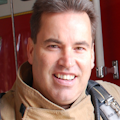
Daniel Byrne
DANIEL BYRNE is a community support officer for the Burton Fire District, Beaufort County, SC, and a retired assistant fire chief of training for the Georgia Air National Guard 165th Fire Department. A third-generation firefighter, he holds an associate degree and a bachelor’s degree in fire science as well as a master’s degree in public administration and disaster management. Byrne is an alumnus of the National Fire Academy. He received state and local awards for public relations and educational programs as well as community partnerships and served as a conference presenter and keynote speaker.
